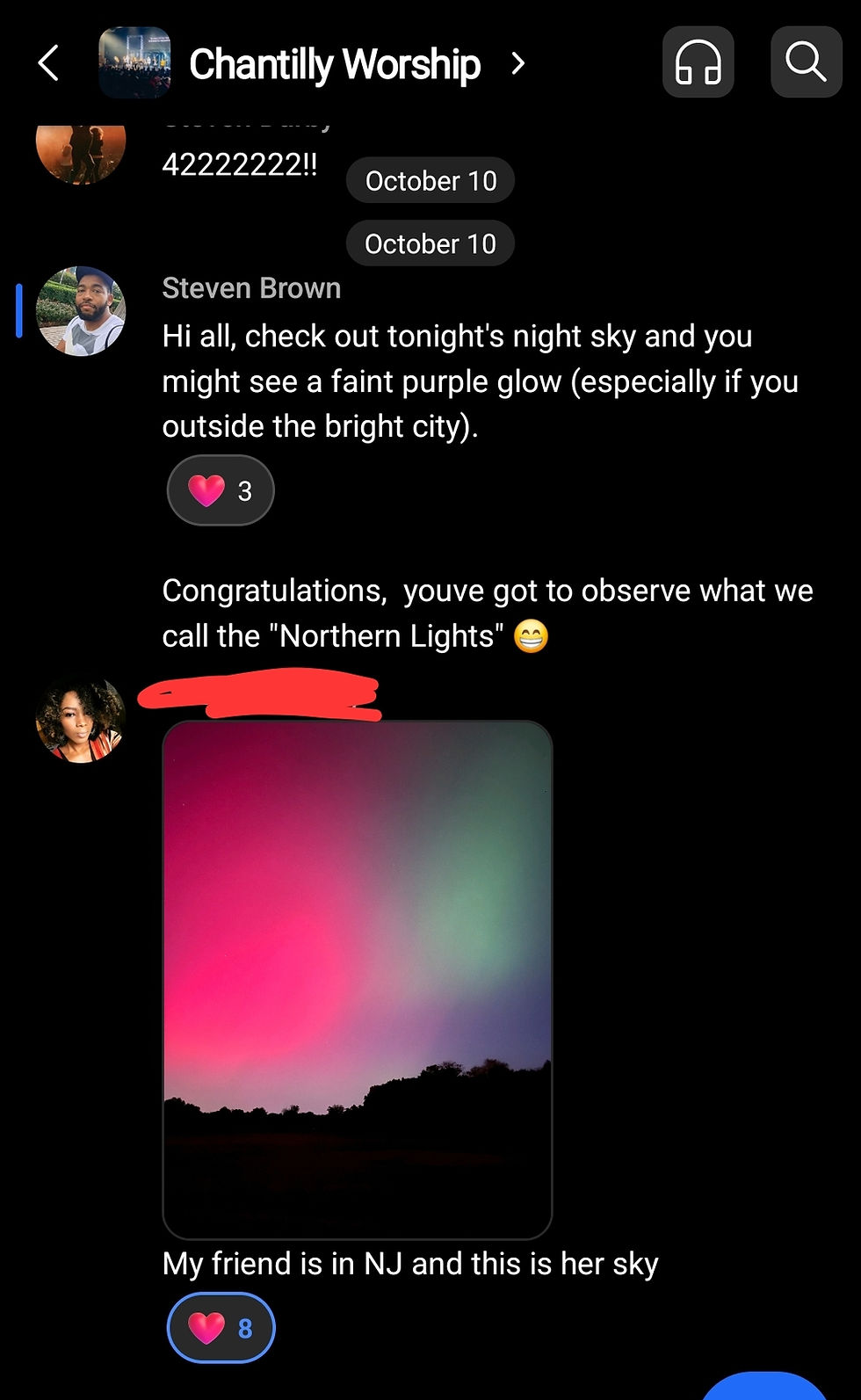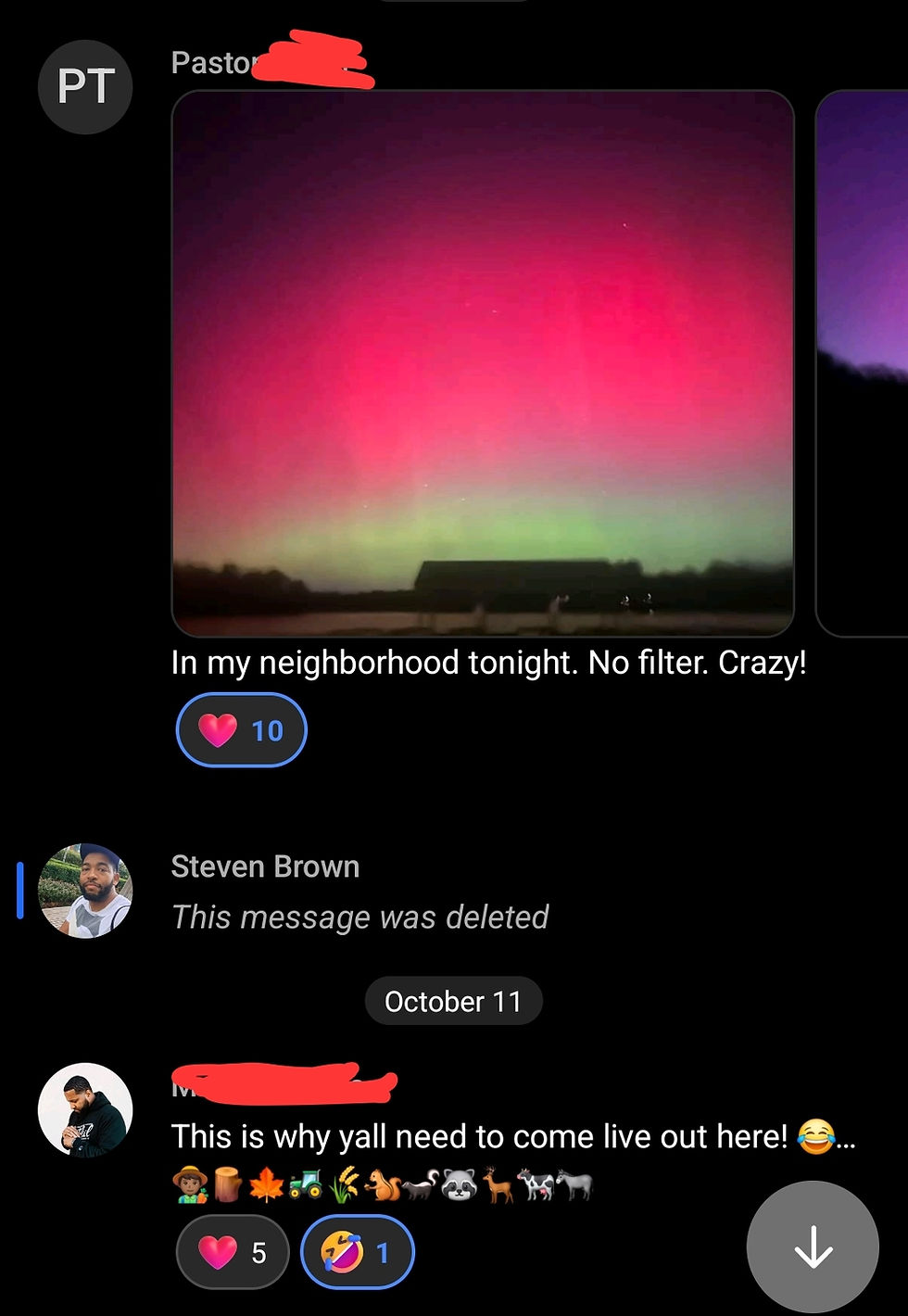Northern Lights in Washington, D.C.: A Rare Cosmic Display Over the Capital.
- Steven Brown
- Oct 14, 2024
- 4 min read
Introduction
Last week, residents of Washington, D.C., witnessed an astonishing sight that is near and dear to my heart: the northern lights, or aurora borealis, dancing above the city. In the midst of my excitement, I messaged my church's worship team to tell them to look up!

And just like that photos started rolling in!

With some lighthearted banter :)

And a challenge from the Pastor:

Of course, that's where the fun begins!
In grad school my advisor told me that one way he likes to introduce the Ionosphere, or Space Weather, to anyone is to start with the Northern lights. "You have to point them to something they can see and interact with. Don't just start yabbering and expect just anyone to care or understand. Grab their attention".
Last week, the Northern transformed the familiar Washginton DC skyline with shades of green, purple, and red, an awe-inspiring phenomenon rarely seen so far south of the Polar regions. The auroras were visible for several hours, peaking late in the evening, and left both locals and tourists mesmerized.
For many, it was a once-in-a-lifetime experience, with the vibrant colors illuminating iconic landmarks like the Washington Monument and the U.S. Capitol. Social media lit up as well, as excited spectators shared photos and videos, amplifying the sense of wonder that permeated the city. As you saw with my worship team, people could both "see" and "interact with" (i.e. take pictures) the rare Northern Lights showing over The Capitol. But let's dig deeper. What did folk actually see?
The Science Behind Auroras
Auroras, also known as the Northern [or Southern] Lights, are natural light displays that usually occur near the polar regions. They’re created when charged particles from the sun collide with Earth’s magnetic field.
Right now, we are experiencing a solar maximum—a period in the sun’s 11-year cycle when solar activity peaks. This means more frequent solar flares and coronal mass ejections, which can lead to powerful geomagnetic storms that expand the range of auroras beyond their usual locations.
The Significance of Auroras in Lower Latitudes
Seeing the auroras in Washington, D.C., was not just a visual treat; it was also a rare event with scientific significance.
Since we are currently in a solar maximum, we can expect more frequent geomagnetic storms, pushing auroras beyond polar regions. These geomagnetic disturbances can disrupt GPS signals, interfere with satellite communications, and even pose risks to power grids.
Solar Weather and Rescue Operations During Hurricane Katrina
When Hurricane Katrina struck in 2005, rescue efforts were not only hindered by the storm but also by solar weather effects. During this time, solar storms disrupted GPS and radio communications—both essential tools for emergency responders. With roads submerged and landmarks unrecognizable, accurate GPS was crucial for navigating the disaster zone. However, geomagnetic disturbances affected satellite signals, delaying rescuers and making it difficult to locate people in need.

Radio communications, already essential due to widespread power outages and downed cell networks, were also impacted. Solar activity can interfere with high-frequency radio waves, causing signal loss and static that complicates communication. For rescue teams coordinating efforts across devastated areas, this interference added an unexpected layer of difficulty during an already chaotic situation.
The influence of solar weather during Katrina underscored the need to integrate space weather forecasts into emergency response planning. As we enter another solar maximum, these disturbances could become more frequent. Preparing for potential technology disruptions due to solar activity can help improve emergency responses in the future. By understanding the risks posed by solar weather, responders can better equip themselves to handle such challenges and potentially save lives when it matters most.
Capturing the Moment: Tips for Photographing Auroras
If you were lucky enough to witness the auroras over Washington, D.C., you might have been tempted to capture the moment on camera.

While Samsung cameras generally outperform iPhones in low-light conditions, you can use a tripod, adjust the ISO, and manually focus to infinity to achieve better results.
Why This Event Is Important for Science and Public Awareness
The unexpected appearance of auroras over Washington, D.C., wasn’t just a rare visual spectacle; it was also a valuable reminder of the importance of space weather and its impact on our daily lives. During this solar maximum, events like these spark public interest, raising awareness about the importance of understanding our connection to space.
Reflecting on a Night of Celestial Wonder
The northern lights over Washington, D.C., offered a rare and mesmerizing experience, turning the city into a temporary canvas painted by the cosmos. It was a moment that united locals and tourists alike, each captivated by the stunning display of colors that lit up the familiar skyline.
For me, the Northern Lights are yet another sign of intentional, intelligent design - evidence of a Creator. The energetic particles that cause the Northern lights, brought about by a violent geomagnetic storm, would likely harm or even kill us if we were ever exposed to it (go watch the end of "The Knowing" if you don't believe me).
However, life on Earth is protected by 1) a geomagnetic field, that deflects much of the solar wind away from Earth and 2) an atmosphere that absorbs the potentially harmful energetic particles yet....all we see, from the ground, is a light show - The sky above DC transformed into an art canvas. That's no random occurrence...
Want to Learn More?
“NASA’s Space Weather Information” (https://www.nasa.gov/spaceweather)
“NOAA’s Aurora Forecast” (https://www.swpc.noaa.gov/products/aurora-30-minute-forecast)
“Tips for Night Photography on Digital Photography School” (https://digital-photography-school.com/night-photography-tips/)
“The Science Behind Auroras by National Geographic” (https://www.nationalgeographic.com/science/article/auroras)
“Real-Time Aurora Monitoring on SpaceWeatherLive” (https://www.spaceweatherlive.com/en/auroral-activity)
"Space Weather – Impacts, Mitigation and Forecasting" (http://www.spaceweather.org/ISES/swxeff/5.pdf)




Comments